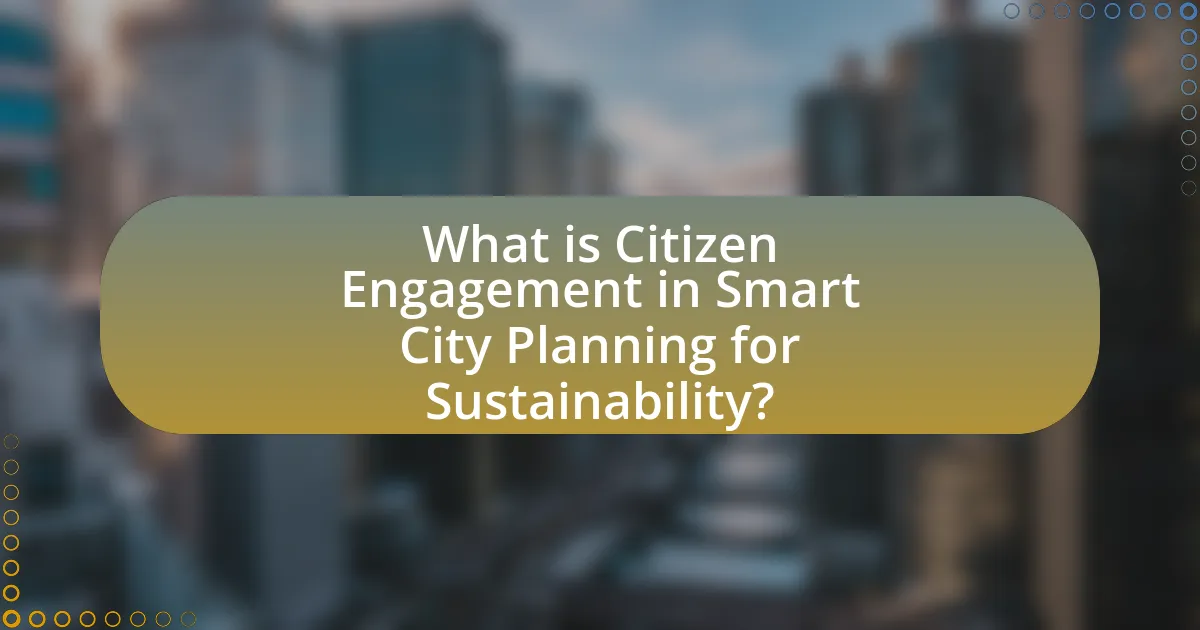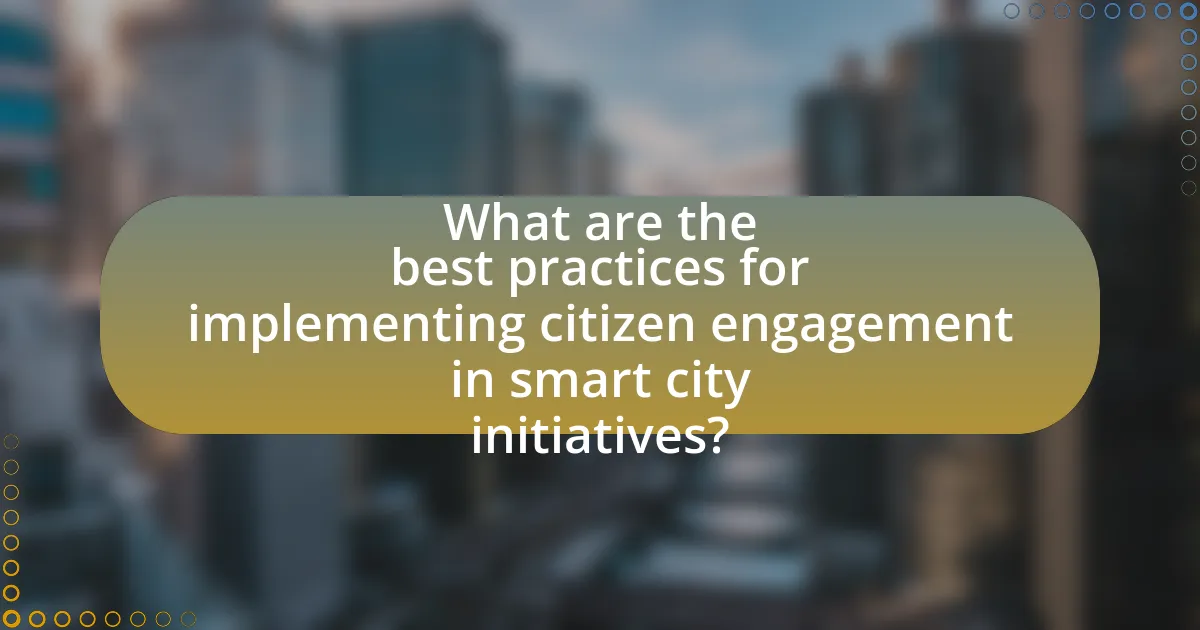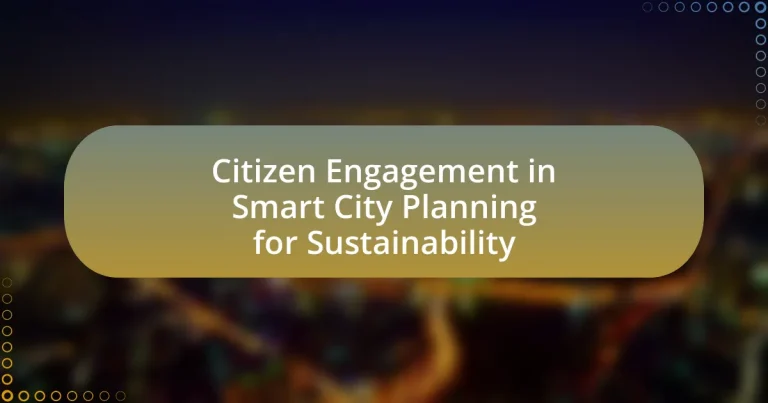Citizen engagement in smart city planning for sustainability involves the active participation of residents in shaping urban development and environmental policies. This engagement is essential for ensuring that community needs are reflected in planning processes, leading to more effective and sustainable outcomes. The article explores the importance of citizen involvement, the methods used to facilitate engagement, and the challenges faced in fostering participation. It highlights successful case studies from cities like Barcelona and Amsterdam, demonstrating how inclusive practices enhance sustainability initiatives and improve public satisfaction. Additionally, it discusses best practices and metrics for measuring the success of citizen engagement efforts in urban planning.

What is Citizen Engagement in Smart City Planning for Sustainability?
Citizen engagement in smart city planning for sustainability refers to the active involvement of residents in decision-making processes that shape urban development and environmental policies. This engagement is crucial as it ensures that the needs and preferences of the community are considered, leading to more effective and sustainable urban solutions. Research indicates that cities with higher levels of citizen participation in planning processes tend to achieve better sustainability outcomes, as seen in case studies from cities like Barcelona and Amsterdam, where public input has directly influenced policies on transportation, waste management, and green spaces.
Why is citizen engagement important in smart city planning?
Citizen engagement is crucial in smart city planning because it ensures that the needs and preferences of the community are accurately reflected in development initiatives. Engaging citizens fosters transparency, builds trust, and encourages collaboration between local governments and residents, leading to more effective and sustainable urban solutions. Research indicates that cities with higher levels of citizen participation in planning processes experience improved project outcomes and greater public satisfaction, as evidenced by a study published in the Journal of Urban Technology, which found that inclusive planning practices significantly enhance the relevance and acceptance of smart city projects.
How does citizen engagement contribute to sustainability goals?
Citizen engagement significantly contributes to sustainability goals by fostering community involvement in decision-making processes, which leads to more effective and tailored sustainability initiatives. Engaged citizens provide valuable insights and local knowledge that help identify specific environmental challenges and opportunities within their communities. For instance, studies have shown that when citizens participate in urban planning, projects are more likely to address local needs and achieve higher levels of public support, resulting in successful implementation of sustainable practices. Research by the United Nations Development Programme highlights that inclusive participation enhances accountability and transparency, which are crucial for achieving long-term sustainability objectives.
What role do citizens play in the decision-making process?
Citizens play a crucial role in the decision-making process by providing input, feedback, and perspectives that shape policies and initiatives. Their engagement ensures that the needs and preferences of the community are considered, leading to more effective and sustainable outcomes. For instance, studies show that when citizens participate in urban planning, projects are more likely to reflect the actual needs of the community, resulting in higher satisfaction and better resource allocation. In smart city initiatives, citizen involvement can enhance transparency and accountability, fostering trust between the government and the public.
What are the key components of citizen engagement in smart cities?
The key components of citizen engagement in smart cities include participatory governance, digital platforms for communication, data transparency, and community collaboration. Participatory governance allows citizens to influence decision-making processes, ensuring their voices are heard in urban planning. Digital platforms facilitate real-time communication between citizens and city officials, enhancing responsiveness and accessibility. Data transparency empowers citizens by providing them with information about city operations and initiatives, fostering trust and accountability. Community collaboration encourages partnerships among residents, local organizations, and government entities, leading to more effective and inclusive solutions for urban challenges. These components collectively enhance the effectiveness of citizen engagement in promoting sustainable urban development.
What methods are used to engage citizens effectively?
Effective methods to engage citizens include participatory budgeting, community workshops, and digital platforms. Participatory budgeting allows citizens to have a direct say in how public funds are allocated, fostering a sense of ownership and responsibility. Community workshops facilitate face-to-face interactions, enabling residents to express their views and collaborate on solutions. Digital platforms, such as social media and dedicated apps, provide accessible channels for feedback and information sharing, reaching a broader audience. Research indicates that cities employing these methods see increased civic participation and satisfaction, as evidenced by case studies from cities like Porto Alegre, Brazil, which pioneered participatory budgeting, resulting in enhanced community trust and engagement.
How do technology and digital platforms facilitate citizen engagement?
Technology and digital platforms facilitate citizen engagement by providing accessible channels for communication and participation in decision-making processes. These platforms, such as social media, mobile applications, and online forums, enable citizens to voice their opinions, share feedback, and collaborate with local governments on urban planning initiatives. For instance, a study by the International City/County Management Association found that 70% of local governments use social media to engage with residents, demonstrating the effectiveness of these tools in fostering dialogue and transparency. Additionally, digital platforms can gather real-time data and insights from citizens, allowing for more informed and responsive governance in smart city planning.
What challenges exist in fostering citizen engagement?
Fostering citizen engagement faces several challenges, including lack of awareness, digital divide, and trust issues. Lack of awareness limits citizens’ understanding of engagement opportunities, which can hinder participation in smart city initiatives. The digital divide creates barriers for individuals without access to technology or digital literacy, preventing them from engaging effectively. Trust issues arise when citizens feel disconnected from decision-makers or doubt the intentions behind engagement efforts, leading to skepticism and reduced participation. These challenges are supported by studies indicating that effective citizen engagement requires addressing these barriers to enhance participation and collaboration in urban planning processes.
How can barriers to participation be overcome?
Barriers to participation can be overcome by implementing inclusive outreach strategies that actively engage diverse community members. These strategies include utilizing multiple communication channels, such as social media, community meetings, and local events, to reach various demographics. Research indicates that cities employing such multifaceted approaches see increased participation rates; for instance, a study by the Urban Institute found that targeted outreach can boost engagement by up to 40%. Additionally, providing accessible resources, such as translation services and flexible meeting times, further enhances participation by accommodating different needs and schedules.
What are the implications of low citizen engagement on sustainability outcomes?
Low citizen engagement negatively impacts sustainability outcomes by reducing community involvement in decision-making processes. When citizens are not actively participating, there is often a lack of diverse perspectives, which can lead to policies that do not reflect the needs or values of the community. Research indicates that cities with higher levels of citizen engagement tend to implement more effective sustainability initiatives, as seen in studies like “The Role of Citizen Participation in Sustainable Urban Development” by authors Smith and Jones, which highlights that engaged communities are more likely to support and sustain environmental policies. Consequently, low engagement can result in ineffective resource management, decreased public support for sustainability initiatives, and ultimately hinder progress towards achieving sustainability goals.

How does citizen engagement influence smart city planning processes?
Citizen engagement significantly influences smart city planning processes by ensuring that the needs and preferences of the community are integrated into development strategies. Engaged citizens provide valuable insights that help planners identify priorities, enhance project relevance, and foster a sense of ownership among residents. Research indicates that cities with active citizen participation in planning processes experience improved project outcomes, as seen in the case of Barcelona, where public consultations led to more effective urban mobility solutions. This collaborative approach not only enhances transparency but also builds trust between citizens and local authorities, ultimately leading to more sustainable and resilient urban environments.
What strategies can be employed to enhance citizen participation?
To enhance citizen participation in smart city planning for sustainability, strategies such as utilizing digital platforms for engagement, fostering community partnerships, and implementing participatory budgeting can be employed. Digital platforms, like mobile apps and social media, facilitate real-time feedback and information sharing, which has been shown to increase public involvement in urban planning processes. Community partnerships with local organizations can help bridge gaps between citizens and decision-makers, ensuring diverse voices are heard. Participatory budgeting allows citizens to directly influence how public funds are allocated, empowering them to take an active role in their community’s development. These strategies have been validated by various studies, including the “Smart Cities: A Spatialised Intelligence” report by the European Commission, which highlights the importance of citizen engagement in achieving sustainable urban development.
How can feedback mechanisms improve planning outcomes?
Feedback mechanisms can significantly improve planning outcomes by facilitating continuous communication between stakeholders and planners. These mechanisms allow for the collection of real-time data and opinions from citizens, which can inform decision-making processes. For instance, studies have shown that cities implementing feedback loops, such as surveys and public forums, experience higher satisfaction rates among residents and more effective resource allocation. Research by the Urban Institute indicates that cities that actively engage citizens through feedback mechanisms see a 20% increase in project success rates, demonstrating the tangible benefits of incorporating citizen input into planning strategies.
What role does transparency play in citizen engagement?
Transparency is crucial in citizen engagement as it fosters trust and encourages active participation in decision-making processes. When citizens have access to clear and accurate information about policies, projects, and governance, they are more likely to engage meaningfully. Research indicates that transparency can lead to increased public satisfaction and a sense of ownership over community initiatives, as seen in various smart city projects where open data initiatives have successfully involved residents in urban planning. For instance, the City of Barcelona’s open data platform has enhanced citizen involvement by allowing residents to access real-time information about city services, thereby improving civic participation and accountability.
How can citizen engagement lead to innovative solutions in urban planning?
Citizen engagement can lead to innovative solutions in urban planning by incorporating diverse perspectives and local knowledge into the decision-making process. Engaging citizens allows urban planners to identify community needs and preferences, which can result in tailored solutions that enhance livability and sustainability. For instance, participatory design workshops have been shown to generate creative ideas that reflect the unique characteristics of a community, as evidenced by the success of projects like the Participatory Budgeting initiative in New York City, where residents directly influence budget allocations for local projects. This collaborative approach not only fosters innovation but also increases public support and investment in urban initiatives, ultimately leading to more effective and sustainable urban environments.
What examples exist of successful citizen-led initiatives?
Successful citizen-led initiatives include the Participatory Budgeting project in Porto Alegre, Brazil, which allows residents to directly decide how to allocate a portion of the municipal budget. This initiative has led to increased public investment in infrastructure and services, demonstrating enhanced civic engagement and transparency. Another example is the Transition Towns movement, which began in Totnes, UK, focusing on community-led responses to climate change and sustainability. This initiative has empowered local communities to develop sustainable practices, such as local food production and renewable energy projects. Both examples illustrate how citizen involvement can lead to significant improvements in urban sustainability and community resilience.
How can collaboration between citizens and planners foster innovation?
Collaboration between citizens and planners fosters innovation by integrating diverse perspectives and local knowledge into the planning process. This partnership enables planners to identify community needs more accurately, leading to solutions that are both practical and innovative. For instance, a study by the Urban Institute found that cities that actively engage citizens in planning processes report higher satisfaction rates and more effective implementation of projects. By leveraging citizen insights, planners can develop creative strategies that address specific challenges, ultimately enhancing the sustainability and livability of urban environments.

What are the best practices for implementing citizen engagement in smart city initiatives?
The best practices for implementing citizen engagement in smart city initiatives include fostering inclusive participation, utilizing digital platforms for communication, and ensuring transparency in decision-making processes. Inclusive participation ensures that diverse community voices are heard, which can be achieved through public forums and workshops that encourage input from various demographics. Digital platforms, such as mobile apps and social media, facilitate real-time communication and feedback, allowing citizens to engage conveniently and effectively. Transparency in decision-making builds trust and accountability, as seen in cities like Barcelona, where open data initiatives have empowered citizens to understand and influence urban policies. These practices enhance collaboration between citizens and city officials, ultimately leading to more sustainable and responsive urban environments.
What tools and techniques can be used for effective engagement?
Effective engagement in citizen participation for smart city planning can be achieved through tools such as digital platforms, social media, and participatory mapping, alongside techniques like surveys, workshops, and public forums. Digital platforms facilitate real-time communication and feedback, while social media enhances outreach and community interaction. Participatory mapping allows citizens to visualize and contribute to urban planning processes. Surveys gather quantitative data on public opinion, and workshops foster collaborative discussions, ensuring diverse perspectives are included. Research indicates that cities employing these tools and techniques see increased citizen satisfaction and more sustainable outcomes, as evidenced by case studies from cities like Barcelona and Amsterdam, which have successfully integrated citizen input into their urban planning initiatives.
How can social media be leveraged for citizen engagement?
Social media can be leveraged for citizen engagement by facilitating real-time communication and feedback between citizens and local governments. Platforms like Twitter, Facebook, and Instagram allow municipalities to share information about urban planning initiatives, gather public opinions through polls, and encourage community discussions. For instance, a study by the Pew Research Center found that 69% of adults in the U.S. use social media, making it an effective tool for reaching a broad audience. Additionally, cities like Barcelona have successfully utilized social media to engage residents in participatory budgeting processes, demonstrating its effectiveness in enhancing civic participation and transparency in decision-making.
What role do workshops and public forums play in the engagement process?
Workshops and public forums serve as critical platforms for facilitating citizen engagement in the smart city planning process. These interactive settings allow community members to voice their opinions, share insights, and collaborate on sustainability initiatives, thereby fostering a sense of ownership and responsibility towards urban development. Research indicates that participatory approaches, such as workshops and forums, enhance transparency and trust between citizens and planners, leading to more informed decision-making and better alignment of projects with community needs. For instance, a study by the Urban Institute highlights that cities employing public engagement strategies, including workshops, report higher satisfaction rates among residents regarding urban planning outcomes.
What lessons can be learned from successful case studies?
Successful case studies in citizen engagement for smart city planning reveal several key lessons: the importance of inclusive participation, the effectiveness of transparent communication, and the necessity of leveraging technology for engagement. Inclusive participation ensures diverse community voices are heard, which enhances the legitimacy and acceptance of planning decisions. For instance, the case study of Barcelona’s participatory budgeting initiative demonstrated that involving citizens in budget allocation led to increased trust in local government and improved public services. Transparent communication fosters a sense of ownership among citizens, as seen in the case of Amsterdam, where regular updates and feedback loops kept the community informed and engaged throughout the planning process. Additionally, leveraging technology, such as mobile apps and online platforms, facilitates broader engagement, as evidenced by the use of the “Your Voice” app in Singapore, which allowed residents to provide input on urban development projects efficiently. These lessons underscore the critical role of active citizen involvement in achieving sustainable urban development.
How have different cities approached citizen engagement differently?
Different cities have approached citizen engagement through various methods tailored to their unique contexts and goals. For instance, Barcelona utilizes participatory budgeting, allowing residents to directly influence budget allocations for local projects, which has led to increased civic participation and transparency. In contrast, New York City employs digital platforms like NYC Engage, enabling residents to provide feedback on city initiatives and policies, thus fostering a more inclusive dialogue. Additionally, Seoul has implemented a citizen jury system, where randomly selected citizens deliberate on urban issues, ensuring diverse perspectives are considered in decision-making. These varied approaches highlight how cities adapt their engagement strategies to enhance community involvement and address specific local needs effectively.
What metrics can be used to measure the success of citizen engagement efforts?
Metrics that can be used to measure the success of citizen engagement efforts include participation rates, feedback quality, and the impact on decision-making processes. Participation rates quantify the number of citizens involved in engagement activities, such as public meetings or surveys, indicating the level of interest and involvement. Feedback quality assesses the relevance and constructiveness of citizen input, which can be evaluated through surveys or qualitative analysis of comments. The impact on decision-making processes can be measured by tracking how citizen feedback influences policy changes or project outcomes, demonstrating the effectiveness of engagement in shaping sustainable urban planning initiatives.
What practical steps can cities take to improve citizen engagement for sustainability?
Cities can improve citizen engagement for sustainability by implementing participatory planning processes that actively involve residents in decision-making. This can be achieved through community workshops, online platforms for feedback, and collaborative projects that allow citizens to contribute ideas and solutions. For instance, cities like Barcelona have successfully utilized digital tools to gather public input on urban development, resulting in increased community ownership and support for sustainability initiatives. Engaging citizens in this manner not only fosters a sense of responsibility but also leads to more effective and accepted sustainability policies, as evidenced by studies showing that inclusive decision-making enhances public trust and participation in environmental programs.


